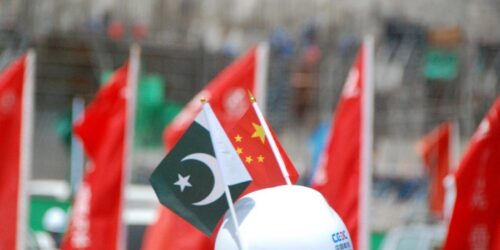Under CPEC Phase II, Pakistan Aims for Deeper Economic and Technological Partnerships with China
BEIJING APP: According to Ambassador to China Khalil Hashmi, Pakistan is looking to expand its collaboration with China in important domains including Economic and Tech and innovation within the context of the second phase of the China-Pakistan Economic Corridor (CPEC).
Ambassador Hashmi recently discussed the main points of China’s yearly “Two Sessions,” a significant political gathering where the Chinese government sets its goals and strategic course, in an interview with China Economic Net. He emphasized China’s remarkable economic growth and its position as a global leader in innovation, stressing that Pakistan sees a lot of potential in adopting China’s development strategy.
Important Lessons Learned from China’s Two Sessions
Despite global economic concerns, Ambassador Hashmi pointed out that China’s goal of 5% GDP growth demonstrates strong internal stability and strategic planning. He emphasized China’s dedication to “new quality productive forces,” particularly in the fields of digitization, ecological development, and high-tech sectors like artificial intelligence, renewable energy, and electric cars.
hvi=3&fsb=1&dtd=725
The ambassador stated, These are not just domestic priorities. China’s emphasis on Economic and Tech will have an impact on the world, especially on emerging countries like Pakistan. In addition to being a significant power, China is a welcoming partner for the Global South.
Strengthened Cooperation in Economic and Tech
Pakistan is actively pursuing the following goals to improve bilateral collaboration in emerging technologies:
- Artificial Intelligence (AI) Robotics in Blockchain
- Technologies for next-generation communication (5G and beyond)
China is a key partner in collaborative research and development, according to Hashmi, as it leads the globe in creativity and patent applications. Pakistan is eager to benefit from this knowledge in order to increase its own technological capabilities and industrial competitiveness.
“We’re moving toward a diversified approach with strong business-to-business (B2B) and government-to-government (G2G) engagements under CPEC Phase II,” he stated. High-priority industries include manufacturing, agriculture, and information technology.
The breadth of new alliances is demonstrated by the more than 45 new Memorandums of Understanding (MOUs) worth more than $600 million that have recently been inked between Chinese and Pakistani firms.
Collaboration in Space, Education, and Skills
The improvement of technical education and vocational training is a fundamental component of the future partnership. Through the promotion of university-industry links, Pakistan seeks to close the gap between academic research and commercial implementation.
A significant development in the two nations’ expanding space cooperation is the announcement made by Ambassador Hashmi that Pakistani astronauts will shortly accompany a Chinese space mission.
“This illustrates the broadening scope of collaboration,” he said. It symbolizes profound trust and common goals in addition to being economically significant.
Trade, Travel, and Interpersonal Relationships
China’s ongoing “high-level opening-up” strategy offers Pakistan additional avenues for international investment, trade, and tourism. Ambassador Hashmi underlined how crucial it is to streamline visa requirements in order to promote easier travel and cultural exchanges.
“Increasing people-to-people connectedness requires ease of mobility. This will strengthen our already robust diplomatic ties even more,” he said.
A Strategic Perspective for 2025 and Later
This year, Pakistan’s leadership is actively looking for Chinese investment and expertise to support growth, with a particular focus on eight critical areas. These consist of:
Agriculture
Information Technology
Manufacturing
Renewable Energy
Logistics
Minerals and Mining
Tourism
Education and Vocational Training
China-Pakistan Mutual Gain
According to experts, CPEC is an essential tool for trade route diversification because of Pakistan’s advantageous location, which allows China access to markets in South Asia and the Middle East. Additionally, Chinese companies can increase their global presence, particularly in emerging countries, through joint ventures in robotics, AI, and IT.
One researcher claimed that these partnerships are advantageous to more than simply Pakistan. “They foster shared development throughout the Global South while providing China with strategic advantages.”
CPEC Phase II is set to become a pillar of regional connectivity, economic expansion, and technological innovation as both nations strengthen their bonds, solidifying what they both proudly refer to as their “ironclad friendship.”






